- Read about Shivaji’s Sukarmas, achievements and an Indic view on Caste that is different from the common narrative.
In the week during which PM Modi referred to Shivaji whilst speaking at
the inaugural function of the Kashi Vishwanath Corridor respected U.S. based Professor
of South Asian History, Dr. Audrey Truschke tweeted about Shivaji Maharaj. Excerpts from thread of tweets posted on December 13, 2021 at 7.18 pm, ‘Shivaji was born a Sudra, in a world where caste mattered. Shivaji then underwent an elaborate ceremony where he reclaimed his "rightful" (read: newly invented) kshatriya status and proclaimed himself chhatrapati (emperor). Shivaji went to Aurangzeb's court in 1666 and made a scene, bucking Mughal-Rajput court protocol. Shivaji's story is a great place to see how caste mattered in early modern India.’
These tweets dampened the spirit of some social media supporters of Shivaji. The discussion naturally moved away from his achievements and instead focus on Shivaji’s caste. This is a sophisticated approach to put Indians on the defensive, create self-doubt and make them quarrel amongst themselves.
This article has an Indic view on caste. Two, touches upon Shivaji’s achievements. Let us start with Shivaji’s sukarmas.
Shivaji’s Sukarmas
“The foundation of the Maratha power was laid in the first half of the seventeenth century. The Marathas were scattered in small groups not only in Maharashtra but all over the country. The main credit goes to Shivaji for bringing all these Marathas together under one flag and standing against the foreign powers. Shivaji fought tirelessly against the Mughal Empire and the Adil Shahi sultanate, creating a kingdom for Indians. Later in the eighteenth century, Shivaji’s followers transformed the kingdom into an empire. Shivaji not only fought against the Mughals with guerilla warfare but also defeated them in open battlefield.”
A man is known by his
karmas, achievements and impact rather than caste. Shivaji overpowered Afzal
Khan, defeated the Mughals (Battle of Salher) and made life difficult for
Aurangzeb. He was also a Naval visionary. In fact after losing to the Marathas
in the Battle
of Salher Aurangzeb did not emerge for
the pubic audience for three days.
Shivaji laid the foundation for
future generations of Marathas to extend their empire beyond Maharashtra for
e.g. Baji
rao Peshwa and Madhav
rao Peshwa
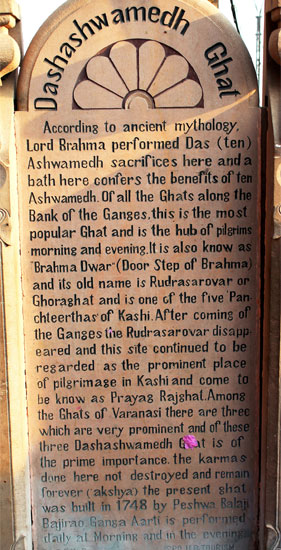 Kashi Ghat built in 1748 by Peshwa Balaji Bajirao.
Kashi Ghat built in 1748 by Peshwa Balaji Bajirao.
Post Shivaji’s dramatic escape from Aurangzeb’s custody in Agra, “Shivaji’s reputation, reached its zenith for having outwitted the cleverest and mightiest of the emperors. 1 Pg 264. Such a strain (1670-73), called forth the best qualities of Maratha character- spirit of sacrifice and cooperation, and a sense of national unity, which Shivaji’s unique leadership evoked in his followers and which for a time the Maratha name respected all over India. 1
Note that Gandhiji coined the term Hind Swaraj, echoing the terminology of Hindavi Swarajya coined by Shivaji Maharaj in 1645. 4 Pg. 32
Read articles on Maratha History by author and historian Dr Uday Kulkarni
1. The
saga of Raja Shivaji - From Agra to Salher
2. Shivaji Maharaj – A Naval visionary
3. Chhatrapati Shivaji – The King who cared for his people Part 3
4. 18th
century is termed as the Maratha Century due to Maratha dominance over India
5. How
the Marathas captured Attock in modern day Pakistan
However, some are obsessed
with Caste and not achievements.
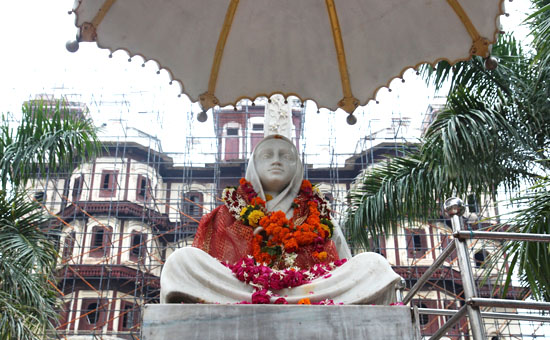 Ahilyabai Holkar belonged to the shepherd community.
Ahilyabai Holkar belonged to the shepherd community.
Interestingly few talk about the
caste of Ahilyabai Holkar (Queen and Ruler of Malwa) who belonged to the Dhangar
(shepherd) community, whom Paramhansa Yogananda, author of Autobiography of a Yogi, described “as the greatest woman of modern India” Source
OR about her father-in-law Malhar rao Holkar, the Subedar of Malwa. (Read about
him here) Today the Dhangar community want to be treated as Scheduled Caste, so as to avail government jobs and doles. None talk of Tanhaji’s caste, the man who won the Battle of Sinhagad. He belonged to the Koli community. To see album of Haldi Festival celebrated by Dhangar community Here
Actually, some learned cherry pick caste of people. When Nirbhaya was raped in 2012, the media did not tell us she was a Brahmin girl. Now suppose she was a scheduled caste girl the narrative would be different.
Incidentally, the nomenclature used to describe the backward classes keeps changing. In the 1890s they were called the depressed classes. In the early 1930's, Mahatma Gandhi named them "harijans". The Government of India Act, 1935 introduced the term "scheduled caste" while "scheduled tribe" came into being after the Constitution was adopted. To see album of Kathi Holi celebrated by the adivasis of Maharashtra, Gujarat etc Here
The former rulers of
Tripura are now classified as Scheduled Tribes. So there is a bust of Dr Ambedkar
at their palace gate in Agartala.
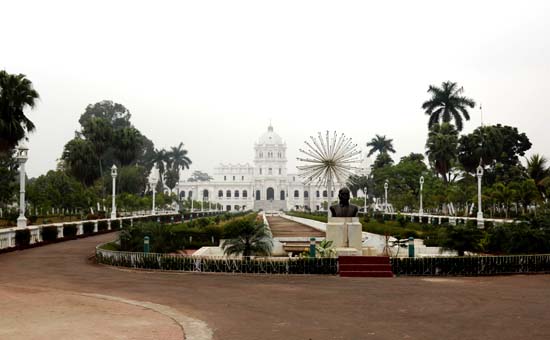 Ujjayanta Palace, Agartala.
Ujjayanta Palace, Agartala.
Just like the words ‘South Asia’ came into prominence in the 1970’s so has the word Dalit come into prominence since the 1990s. There are national commissions for the scheduled castes and backward classes but nowhere is the word Dalit used. The word Dalit is said to be an American Church construct. Also read History
of word Dalit Many Indians follow these terms blindly.
Is the word Caste Indian in origin. No it of Spanish origin and fails to capture the meaning of the Indian term “jati,” which more properly translates as “community.” Jati in traditional India promoted and preserved diversity and multiculturalism by allotting every jati a particular space and role in society so that no jati would be appropriated or dominated by another. Moreover, the jati system was integral to the survival of the Indian nation.
Note Gandhian Dharampalji wrote in Rediscovering
India, “For the British, as perhaps for some others before them, caste has been a great obstacle, in fact, an unmitigated evil not because the British believed in casteless-ness or subscribed to a non-hierarchical system but because it stood in the way of their breaking Indian society, hindered the process of atomisation, and made the task of conquest and governance more difficult.”
Swami Vivekananda said, “Caste is an imperfect institution, no doubt. But if it had not been for caste, you would have had no Sanskrit books to study. This caste made walls, around which all sorts of invasions rolled and surged but found it impossible to break through.”
Well known author and
former head of Proctor and Gamble India Gurcharan Das said in Mint, “I was reading the Forbes’ list of (Indian) billionaires for 2007; I remember most of the names belong to great trading communities. So the much reviled caste system may have come to our aid when it came to the economic rise of India. " Source
Columnist Aakar Patel wrote in the Mint that the current situation in
Pakistan is because of an imbalance in caste. The situation arose because there
is no mercantile caste in Punjab after the Khatri-Arora combine migrated to
India in 1947. Source
However, divisions
created by the British have got so ingrained in our psyche.
There is an often perpetuated myth that Sudras were denied education etc.
Noted Gandhian Dharampalji went through British and Indian archives to reproduce reports of surveys undertaken by the British in Bengal, Punjab and Madras Presidency (1800-1830). According to the collectors’ reports reviewed by Governor Sir Thomas Munro on 10 March 1826, of the 30,211 male school students in Madras Presidency, 20 percent were Brahmins and Chettris, 9 percent were Vaishyas, 50 percent were Shudras, and 6 percent were Muslims. Others constituted 15 percent.
Madras Presidency then consisted of areas that
fall in modern day Tamil Nadu, Andhra, Orissa, Kerala and Karnataka. Another
report by J Dent, Secretary, Fort George, dated 12 February 1825, stated that
out of 1,88,680 scholars in all collectorates of Madras Presidency, Brahmins
were 23%, while Shudras constituted 45%. (Indigenous Education in the 18th
Century). Read excerpts here
PTI
These percentages indicate that Shudras
comprised the majority of students and scholars in these regions.
Read articles on Caste
1. When
caste was not a bad word
2. Impact
of Census 1881 by Dharampalji
3. Vedas
and other scriptures on Caste
4. Why
we cannot be so one-dimensional on caste
5. Caste
as social capital
6. How India's Family communities (Marwaris, Gujaratis, Chettiars etc) fostered enterpreneurship
Some argue that our scriptures sanction caste.
What do our Scriptures say about Caste?
Chapter IV, verse 13 of The Bhagavad Gita reads: “The fourfold-caste has been created by Me according to the differentiation of Guna and Karma, though I am author thereof, know Me as non-doer and immutable”. Krishna tells Arjuna, depending upon a person’s Guna (aptitude) and Karma (actions), there are four Varnas (castes). As per this shloka, a person’s Varna is determined by his Guna and Karma, and not by his birth.
Further, Chapter XIV specifies three Gunas – viz. satva (purity), rajas (passion and attachment) and tamas (ignorance). These three Gunas are present in every human in different proportions, and determine the Varna of every person. Accordingly, depending on one’s Guna and Karma, every individual is free to select his own Varna. Consequently, if their Gunas and Karmas are different, even members of the same family can belong to different Varnas.
Note that a large number of ancient Hindu rishis and saints belonged to the lower castes. Valmiki, author of the Ramayana, was low-caste. Vyasa, author of the Mahabharata, was the son of
Satyawati, the daughter of a fisherman and a wandering sage. Tiruvalluvar, the
Tamil poet-saint was a weaver by caste. Tirupann, the Alvar saint was panar, an
untouchable caste, Tukaram of Maharashtra was a low-caste (sudra) peasant. Ramananda,
the Vaishanava saint of North India, taught the fundamentals of Bhakti to
Ravidasa, a cobbler. 2 Pg. 72.
Having said that, the Varna system has degenerated over the years (why is a different story). Former British Council Scholar Dr Satish Kapoor wrote in Hinduism Eternal, "Note that Abbe J.A. Dubois, a Christian missionary of eminence, who stayed in India from 1792 to 1823 wrote thus, “This plan of dividing the people of India into castes is not confined to the law givers of India.” 2 Pg. 66 Author J Sai Deepak wrote in India that is Bharat, “But I am suggesting that it was under the British that ‘caste’ became a single term capable of expressing, organizing and above all ‘systematiszng India’s diverse forms of social identity, community and organization.” Pg. 304
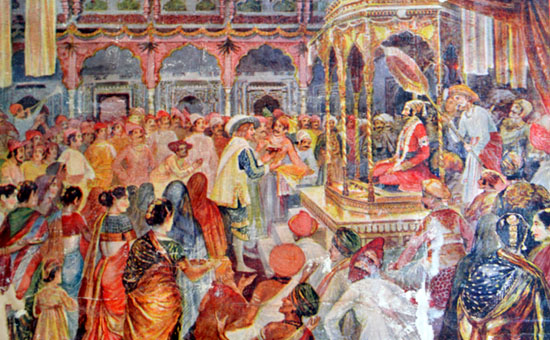
Shivaji Maharaj Coronation
Note - Lukhji Jadhava (descendant of the rulers of Devagiri,
now Daulatabad, who were subjugated by Ala-ud-din Khilji towards the end of the
13th century) had a clever daughter named Jija Bai. She, had vivid
memories of her royal ancestors of Devagiri, was married in 1605 to Shahji i.e.
father of Shivaji. 1 pg.247 Three generations of Bhonsle’s Malhoji, Shahji, Shivaji defended the Deccan against Jahangir, Shah Jahan and Aurangzeb.
The caste system as it exists today in Maharashtra did not
exist then, probably thanks to the Bhakti Movement.
All were called Marathas unlike today.
Author
Aneesh Gokhale wrote in Swarajyamag, “Particularly in Maharashtra, the Bhakti movement ran parallel to the
eclipse of the Hindu power and the rise of the Deccan sultanates. This was the
most trying time for the people, who, having lost the state patronage of their
religion, now turned to simple bhakti as propounded by the likes of Sant
Dyaneshwar, Eknath, Namdev, Tukaram and others.
“The great historian Kashinath Rajwade sums up their contribution – At a time when the open display of the Hindu religion was obliterated, the Bhakti movement through its simplicity of worship, bhajans and kirtans kept the masses within the Hindu fold. Thus, their contribution to our country is priceless.” (Maharashtrachi Shivkalin Samajrachna).”
Now, why was the coronation of Shivaji important?
“After the sovereign kingdoms of Delhi (Indraprastha), Chittor, Karnavati, Devgiri, Vijayanagar and Warangal came to an end, no Hindu king had become sovereign on Indian soil, none had been crowned king.”
“The coronation of Shivaji is an extraordinary event in Indian history. The general belief was that the Mughal Empire represented India’s sovereignty. The treaties with the Mughals would be considered as treaties with India. In the international documents of those days the Mughals would be referred to as the ‘Great Mughal’ or the ‘Emperor of India’. Excluding the European colonies along the coast, there was no ‘independent’ region in Hindustan. All the Rajput states, all the sultanates of the Deccan were vassals of the Mughals. If a king or Sultan died, the Mughals would take over their state, unless they paid an indemnity.”
“There were three major signs of Mughal sovereignty.
1. To mint the gold coins in the name of the Mughal emperors.
2. To read the khutaba
all over the country in the name of the Mughal emperors.
3. To run a julus
(Calendar or Chronology) in the name of the Mughal emperors.
On his coronation, Shivaji did three
important things to avoid being considered as a mansabdar of the
Mughals.
1. Held an umbrella on his head and called
himself ‘Chhatrapati’.
2. Minted gold coins in his name.
3. Since the day of his coronation, he
started the Rajyabhishek era. It was named ‘Rajyabhishek Shak’ (Coronation Era). Shivaji initiated these three aspects of sovereignty from the day of the coronation.”
Actually papers with the title Chhatrapati indicate that a small cohesive independent State with ministers and officials with definitive duties came into being around 1653, although the final shape took many years to be completed. Shivaji’s seal on all official papers issued by him read, “This seal of Shiva, son of Shah, shines forth for the welfare of the people and is meant to command increasing respect from the universe like the first phase of the moon.” 1 Pg. 255 The seal is found attached to papers 1648 onwards.
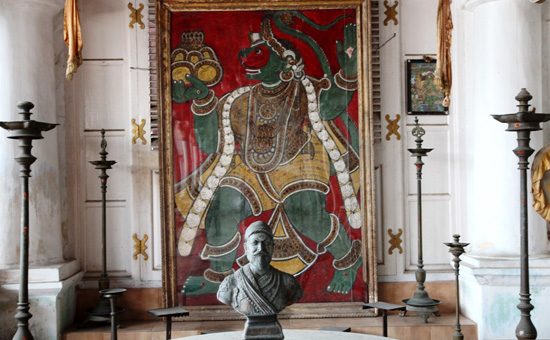 Maratha Palace Tanjore, Tamil Nadu.
Maratha Palace Tanjore, Tamil Nadu.
However, much as I dislike talking about Shivaji’s caste here are some quotes.
“In the Adnyapatra of Ramchandrapant Amatya (edited by A.R.
Kulkarni, see pp 220-1, 332 and 389), it is said, ‘he generated the
Marathas of the ninety six noble families’, and the Bhonsles are included in noble families in the list given.”
Author Aneesh Gokhale wrote in Swarajyamag – “The scriptures were clear that only an “Abhishikta Raja” had the right to govern. The rajabhishek or
coronation ceremony is essentially the process to make Chhatrapati Shivaji
an Abhishikta Raja.”
“Through this ceremony, Shivaji Maharaj was raised to the status of Vishnu and Indra and thus, considered a representative of the Gods. Just like we pour panchamrut over
murtis and perform their abhishek, so was the case with the Rajabhishek.”
“Thus, by doing so, Chhatrapati Shivaji represented a clear break from the contemporary Mughal and Sultanate traditions. The entire ceremony, lasting over several days, is provided in Pandit Gagabhatt’s – Shiv Rajyabhishek Prayogah.”
“It had various Hindu rituals as part of the coronation ceremony, including the Ishanyayagya,
Grahayagya, Nakshatra Yagya and several others. Being associated with Indra, Chhatrapati Shivaji also ascended a throne made from the branches of the Umber tree to signify he was sitting on Indra’s throne as his representative.”
Some learned associate Hinduism with caste. However, they rarely extensively write about social divisions in other religions etc.
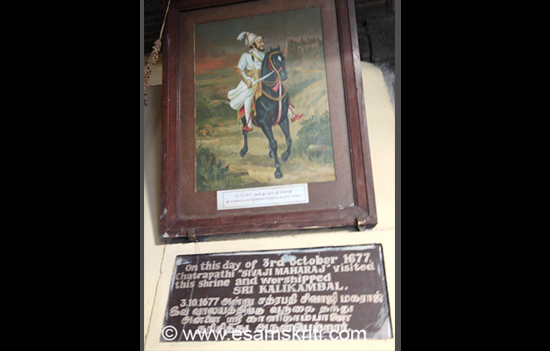 Shivaji visited this temple in Chennai in 1677.
Shivaji visited this temple in Chennai in 1677.
Dr BR Ambedkar wrote in Thoughts on Pakistan (1941), “Indian Muslims themselves recognise two main social divisions, (1) Ashraf or Sharaf and (2) Ajlaf. Ashraf means ‘noble’ and includes all undoubted descendants of foreigners and converts from high caste Hindus. All other Mahomedans, including the occupational groups, and all converts of lower ranks, are known by the contemptuous terms, ‘Ajlaf’, ‘wretches’ or ‘mean people’: they are also called Kamina or Itar, ‘base’ or Rasil, a corruption of Rizal, ‘worthless’. In some places, a third class, called Arzal, or ‘lowest of all,’ is added. With them no other Mahomedan would associate, and they are forbidden to enter the mosque or to use the public burial ground.” Is this true even today?
Similarly, how many articles in Indian media does one read on the genocide of Red Indian Communities by White immigrants. But, this excessive obsession with caste in India.
Based on the above readers can decide whether karmas or caste is important and causes of contemporary caste divisions?
On Shivaji’s death Aurangzeb wrote, “He was a great captain and the only one who had the magnanimity to raise a new kingdom. My armies have been employed against him for 19 years and nevertheless his State has been increasing.” 1 Pg. 277 Sir Jadunath S wrote, “The last great constructive genius and national-builder that the Hindu race has produced. This is Shivaji’s biggest achievement.” “Shivaji has shown that the tree of Hinduism is not really dead, that it can rise from beneath the seemingly crushing load of political bondage, that it can put forth new leaves and branches.”1 Pg. 266
Thus, it is Chhatrapati Shivaji Maharaj’s karmas that he is remembered for, not caste. That is the Indic way.
References
1. The History and Culture of Indian People published by Bharatiya Vidya
Bhavan Volume 7.
2. Hinduism The Faith Eternal by Dr Satish K Kapoor, author, spiritualist and former British Council Scholar.
3. Commentary on the Holy Geeta by Pujya Swami Chinmayanandaji.
4. A New Idea of India by Harsh and Rajeev Mantri.
Also read
1. Ahilyabai
Holkar belonged to the Dhangar or Shepherd community. Album of her palace in
Maheshwar
2. Battle
of Assaye
Pictures in article (except coronation) by Sanjeev Nayyar.